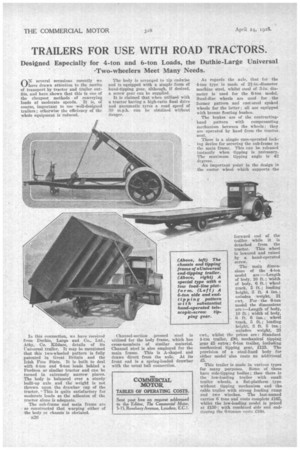TRAILERS FOR USE WITH ROAD TRACTORS.
Page 52

If you've noticed an error in this article please click here to report it so we can fix it.
Designed Especially for 4-ton and 6-ton Loads, the Duthie-Large Universal -Two-wheelers Meet Many Needs.
(IN several occasions recently we V./have drawn attention to the merits of transport by tractor and trailer outfits, and have shown that this is one of the cheapest methods of conveying loads at moderate speeds. It is, of course, important to use well-designed trailers ; otherwise the efficiency of the whole equipment is reduced.
In this connection, we have received from Duthie' Large and Co., Ltd., Athy, Co. Kildare, details of its Universal trailer. It may be mentioned that this two-wheeled pattern is fully patented in Great Britain and the Irish Free State. It is built to deal with 4-ton and 6-ton loads behind a Fordson or similar tractor and can be turned in extremely narrow places. The body is balanced over a sturdy built-up axle and the weight is not thrown upon the drawbar cap of the tractor. This is quite satisfactory for moderate loads as the adhesion of the tractor alone is adequate.
The sub-frame and main frame are so constructed that warping either of the body or chassis is obviated.
1326 The body is arranged to tip endwise and is equipped with a simple form of hand-tipping gear, although, if desired, a screw gear can be supplied.
It is claimed that when utilized with a tractor having a high-ratio final drive and pneumatic tyres a road speed of 30 m.p.h. can be obtained without danger.
Channel-section pressed steel is utilized for the body frame, which has cross-members of similar material. Channel steel is also employed for the main frame. This is A-shaped and draws direct from the axle. At its front end is a spring-loaded drawbar with the usual ball connection.
As regards the axle, that for the 4-ton type is made of 21-in -diameter machine steel, whilst steel of 3-in, diameter is used for the 6-ton model. Steel-disc wheels are used for the former pattern and cast-steel spoked wheels for the latter ; all are equipped. with bronze floating bushes.
The brakes are of the contractingband pattern with compensating mechanism between the wheels; they are operated by hand from the tractor. seat.
There is a simple cam-operated locking device for securing the sub-frame to the main frame. This can be released instantly when -tipping is necessary. The maximum tipping angle is 42 degrees.
An important .point in the design is the castor wheel which supports the
forward end of the trailer while it is detached from the tractor. This wheel is lowered and raised by a hand-operated screw.
The main dimensions of the 4-ton model are :—Length of body, 10 ft.; width of body, 6 ft.; wheel track, 5 ft.; loading height, 3 ft. 4 ins. ; unladen weight, 21 cwt. For the 6-ton model the dimensions are :—Length of body, 10 ft.; width of body, 6 ft. 6 ins.; wheel track, 5 ft.; loading
height, 3 ft. 5 ins„ unladen weight, 23 cwt., whilst the prices are Standard 4-ton trailer, £90, mechanical tipping gear £5 extra; 6-ton trailer, including mechanical tipping gear, £125. The provision of a steel-lined body for either model also costs an additional £5.
This trailer is made in various types for many purposes. Some of these have side-tipping bodies ; then there is the low-loading trailer with small trailer wheels, a flat-platform type without tipping mechanism and the cable trailer with strong loading ramp and two winches. The last-named carries 6 tons and costs complete £165, whilst the low-loading model is priced at £130; with combined side and endtipping the 6-tonner costs £160.




















































































































